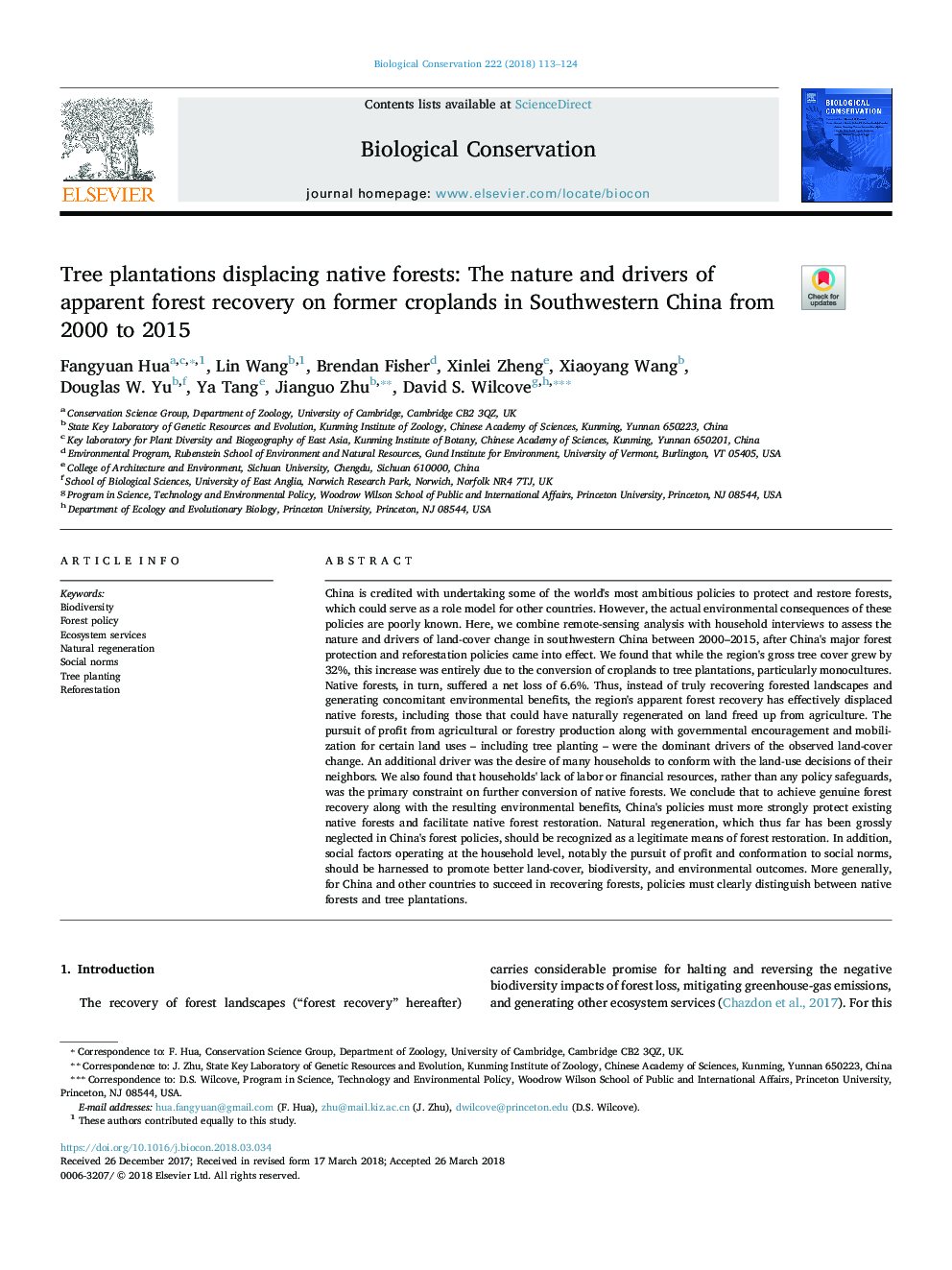| کد مقاله | کد نشریه | سال انتشار | مقاله انگلیسی | نسخه تمام متن |
|---|---|---|---|---|
| 8847261 | 1617883 | 2018 | 12 صفحه PDF | دانلود رایگان |
عنوان انگلیسی مقاله ISI
Tree plantations displacing native forests: The nature and drivers of apparent forest recovery on former croplands in Southwestern China from 2000 to 2015
ترجمه فارسی عنوان
گیاهان درختی که جایگزین جنگل های بومی می شوند: طبیعت و رانندگان جنگل های ظاهری جنگل های سابق در جنوب غربی چین از سال های 2000 تا 2015
دانلود مقاله + سفارش ترجمه
دانلود مقاله ISI انگلیسی
رایگان برای ایرانیان
کلمات کلیدی
تنوع زیستی، سیاست جنگل، خدمات محیط زیستی، بازسازی طبیعی، هنجارهای اجتماعی، کاشتن درخت، جنگل زدایی،
ترجمه چکیده
چین با اتخاذ برخی از سیاست های جاه طلبانه جهان برای حفاظت و بازگرداندن جنگل ها، که می تواند به عنوان یک الگو برای دیگر کشورها عمل کند، اعتبار دارد. با این حال، پیامدهای واقعی زیست محیطی این سیاست ها ناشناخته است. در اینجا، ما تجزیه و تحلیل از راه دور سنجش با مصاحبه های خانگی را برای ارزیابی ماهیت و رانندگان تغییرات پوشش زمین در جنوب غربی چین بین سال های 2000 تا 2015 پس از پیگیری سیاست های حفاظت از جنگل های بزرگ و جنگلداری چین به کار می بریم. ما دریافتیم که در حالی که پوشش درختی ناخالص منطقه به میزان 32 درصد افزایش یافته است، این افزایش به طور کامل به دلیل تبدیل گیاهان به مزارع درختی، به ویژه تک شاخه ها بود. به نوبه خود، جنگل های بومی، از دست دادن خالص 6.6٪ رنج می برد. بدین ترتیب، به جای اصلاح منظر های جنگلی و ایجاد مزایای زیست محیطی، بهبود جنگل های آشکار منطقه، به طور موثری جایگزین جنگل های بومی، از جمله آنهایی است که می توانند به طور طبیعی در زمین های آزاد شده از کشاورزی بازسازی شوند. پیگیری سود حاصل از تولید محصولات کشاورزی یا جنگل همراه با تشویق و بسیج دولت برای استفاده از زمین های خاص - از جمله کاشت درخت - راننده های غالب تغییرات پوشش زمین مشاهده شده بود. راننده اضافی تمایل بسیاری از خانوارها برای اتخاذ تصمیمات استفاده از زمین از همسایگان خود بود. ما همچنین دریافتیم که فقدان منابع کار و یا منابع مالی خانوارها، به جای هر گونه ضمانت سیاستی، محدودیت اصلی برای تبدیل بیشتر جنگل های بومی بود. ما نتیجه می گیریم که برای دستیابی به بهبود واقعی جنگل همراه با مزایای زیست محیطی، سیاست های چین بایستی قوی تر از جنگل های بومی موجود حفاظت و تسهیل ترمیم جنگل های محلی را تسهیل کنند. بازسازی طبیعی، که تا کنون در سیاست های جنگل چین به شدت نادیده گرفته شده، باید به عنوان ابزار قانونی احیا جنگل شناخته شود. علاوه بر این، عوامل اجتماعی در سطح خانوار، بخصوص پیگیری سود و انطباق با هنجارهای اجتماعی، باید به منظور ارتقای پوشش بهتر زمین، تنوع زیستی و نتایج محیطی مورد استفاده قرار گیرد. به طور کلی، برای اینکه چین و سایر کشورها برای بهبود جنگل ها موفق شوند، سیاست ها باید بین جنگل های بومی و گیاهان درختی واضح باشد.
موضوعات مرتبط
علوم زیستی و بیوفناوری
علوم کشاورزی و بیولوژیک
بوم شناسی، تکامل، رفتار و سامانه شناسی
چکیده انگلیسی
China is credited with undertaking some of the world's most ambitious policies to protect and restore forests, which could serve as a role model for other countries. However, the actual environmental consequences of these policies are poorly known. Here, we combine remote-sensing analysis with household interviews to assess the nature and drivers of land-cover change in southwestern China between 2000-2015, after China's major forest protection and reforestation policies came into effect. We found that while the region's gross tree cover grew by 32%, this increase was entirely due to the conversion of croplands to tree plantations, particularly monocultures. Native forests, in turn, suffered a net loss of 6.6%. Thus, instead of truly recovering forested landscapes and generating concomitant environmental benefits, the region's apparent forest recovery has effectively displaced native forests, including those that could have naturally regenerated on land freed up from agriculture. The pursuit of profit from agricultural or forestry production along with governmental encouragement and mobilization for certain land uses - including tree planting - were the dominant drivers of the observed land-cover change. An additional driver was the desire of many households to conform with the land-use decisions of their neighbors. We also found that households' lack of labor or financial resources, rather than any policy safeguards, was the primary constraint on further conversion of native forests. We conclude that to achieve genuine forest recovery along with the resulting environmental benefits, China's policies must more strongly protect existing native forests and facilitate native forest restoration. Natural regeneration, which thus far has been grossly neglected in China's forest policies, should be recognized as a legitimate means of forest restoration. In addition, social factors operating at the household level, notably the pursuit of profit and conformation to social norms, should be harnessed to promote better land-cover, biodiversity, and environmental outcomes. More generally, for China and other countries to succeed in recovering forests, policies must clearly distinguish between native forests and tree plantations.
ناشر
Database: Elsevier - ScienceDirect (ساینس دایرکت)
Journal: Biological Conservation - Volume 222, June 2018, Pages 113-124
Journal: Biological Conservation - Volume 222, June 2018, Pages 113-124
نویسندگان
Fangyuan Hua, Lin Wang, Brendan Fisher, Xinlei Zheng, Xiaoyang Wang, Douglas W. Yu, Ya Tang, Jianguo Zhu, David S. Wilcove,
